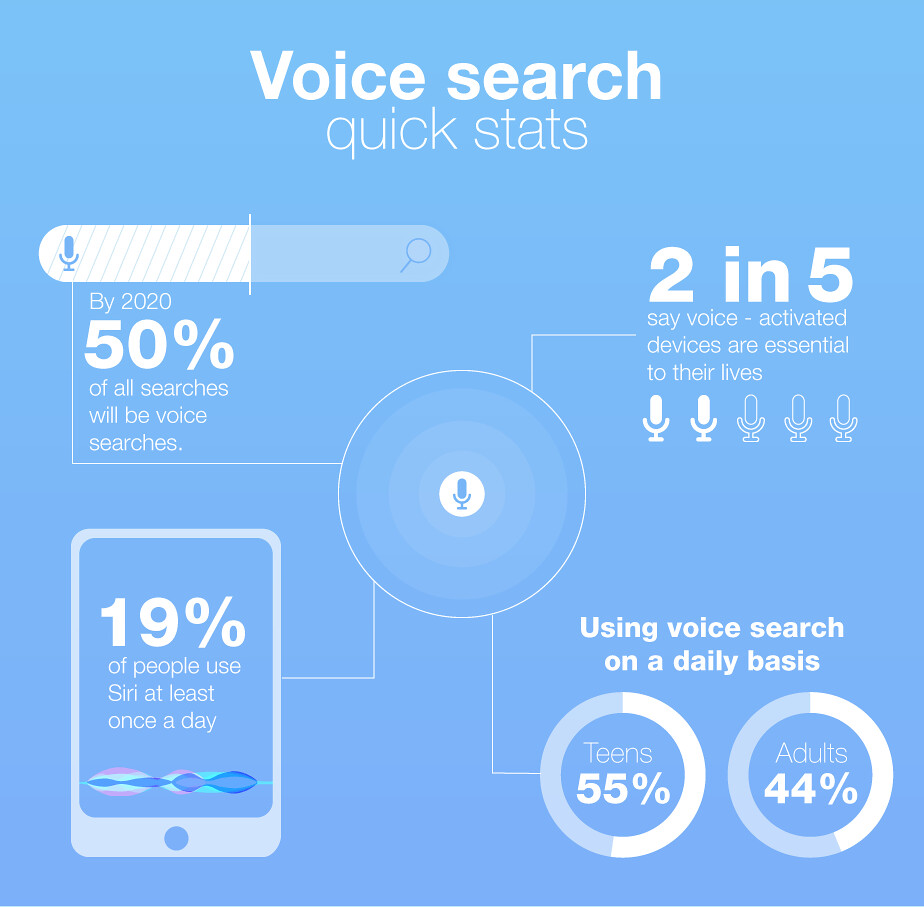On average, you talk at a speed of 150 words per minute.
But you type (on a keyboard) at an average of just 40 words per minute.
So why is it, that every time you switch on a computer or unlock your mobile phone, you’re more inclined to type?
Automatic reaction? Privacy? Visual thinking?
Whatever the answer, according to Apple, Amazon, Microsoft and Google, those reasons aren’t as important as they used to be.
Say hello to the Amazon Echo, Google Home and Apple HomePod. A range of smart speakers, specifically designed with voice search in mind…
…and they aren’t the only devices that are focussing more on voice search…
…mobile users are increasingly using voice to perform almost any action on their handsets. [click_to_tweet tweet=”Voice search is here and it’s not going anywhere. In fact, sooner or later, it’s going to overtake written search.” quote=”Voice search is here and it’s not going anywhere. In fact, sooner or later, it’s going to overtake written search.” theme=”style3″]
You need to be ready for it.
In this article I’m going to hand you a stack of voice search SEO tactics, so you can get ahead of the game and optimise for the next generation of search technology.
Let’s get it…
Contents
What are the Differences Between Voice and Written Searches?
Written searches focus on keywords. So, instead of creating questions or pushing our vocabularies out of first gear, we tend to write things that don’t (really) make sense.
For example, if you’d planned to go out next Tuesday and wanted to pick an outfit…
…you’d search: ‘weather London’.
This would bring up a list of links and a ‘position-zero’ weather forecast for the next 7 days. You’d then scroll through the results for the answer you needed.

However, if you were to make a voice search, it’d look something like this:
‘Hey Siri, what will the weather be this Tuesday?’
Result:
‘The forecast is for rain in London on Tuesday. The high will be 7 degrees and the low will be 4.’
Or, more specifically to business, marketing and voice SEO, you might make a quick voice search like this:
‘Hey Siri, can you recommend any Chinese restaurants near me.’
Result:
‘The best rated one I see is The Oriental Pan Asian Restaurant in Grays, which averages 4 ½ stars.’

BTW: Grays isn’t (very) close to my location. This makes me presume that the AI considers the word ‘recommend’ very important in this voice search (on LSI and semantic search terms).
When I change the search to:
‘Hey Siri, can I book a Chinese restaurant near me?’
Siri’s answer changes to:
‘One possibility I see is Four Seasons, which averages 4 stars and is inexpensive.’

BTW: This Chinese restaurant is less than a mile from my current location because I didn’t make any specific requests in my search, i.e. ‘recommendation’, Siri picked a highly-rated restaurant from close-by.
Marketers can take-away 3 massive things from these simple voice searches:
- We only received one definitive answer on voice search, whilst written queries provide us with a list of results. The value of position 1 (or 0) has just been ramped up, as no other results were voiced in the search. This means that everything from position 2 onwards (even though it can be incredibly hard to achieve a ranking this high) is almost invisible on voice search.
- The search request on voice was structured as a question and much longer than a regular written search.
- The wording of the request can make a massive difference to the results of a voice search. Semantic search and search intent will become increasingly important as AI and search algorithms evolve.
How Many People Use Voice Search?
There are currently more than 1 billion voice searches being made every month and…
…yep, you guessed it, it’s on the rise.
By 2020, it’s predicted that 50% of all searches will be made using voice (comScore).
That’s massive news for marketers and SEO specialists, and with so little time to prepare it’s crucial that you prime every page for voice SEO (I’ll show you how soon). [click_to_tweet tweet=”The most used word in voice search is ‘how’, which is included in 8.64% of all voice search.” quote=”The most used word in voice search is ‘how’, which is included in 8.64% of all voice search.” theme=”style3″]
And just in case you thought voice search was a fad, or a technique used by ‘soft searchers’ who don’t purchase off the back of their voice query:
Products bought directly after a voice search was a $200 million retail segment in the U.K and $1.8 Billion segment in the U.S. all the way back in 2017! It’s predicted to be 20x bigger in 2020! (Voicebot).

The growth and estimated value of voice search is enormous and if you are proactive about voice SEO (and not reactive) you stand to enjoy a much bigger slice of the pie.
My Opinion About Voice Tech
Before we move onto voice SEO tactics, I want to add something else- a personal view on voice tech and search.
In my opinion, voice search is here to say…
…I might be wrong, but I can’t see smart speakers standing the test of time or truly penetrating the market as a must-have for all consumers. They feel like a stepping-stone technology to something bigger.

Instead, I see something else happening, voice search technology being moved (and improved) in other tech that’s already a massive part of our lives.
Think Smart TV’s (my Sky TV already has a voice search button on the remote), mobile (Siri is already amazing, but will definitely get better), desktop and any future AI tech that’s in the prototype stage, particularly wearable tech. [click_to_tweet tweet=”Voice search doesn’t just make our lives easier, it makes it faster to find the answers we’re looking for.” quote=”Voice search doesn’t just make our lives easier, it makes it faster to find the answers we’re looking for.” theme=”style3″]
In an age where productivity and speed of results have never been more valuable, anything that saves time has a big chance of penetrating past the early-adopters and into the mass market.
How Can I Optimise My Website for Voice Searches?
-
Questions and Answers
If people are asking questions in their searches, we better start including those questions in our content and answering them clearly, concisely and immediately.
Think about the questions your target market might ask and use these as headlines (especially H2’s) in your content (look at all the sub-heads in this post!).

Answering specific questions increases your likelihood of hitting the fabled position zero and Google’s ‘featured snippets’.
If you haven’t already, add a FAQ’s page to your website too!
A great place to find relevant questions is AnswerThePublic. Use this website to find questions around your chosen keyword and consider how a user would speak this request (instead of type). And remember to aim for long-tail question keywords.
-
Mobile Optimisation
Voice searches on mobile are growing rapidly. It’s absolutely crucial your website is optimised for it.
Without proper formatting or decent load speeds, your bounce rate and ‘time spent on page’ stats will suffer and Google will deem your website as poor quality and bump you down the rankings. This will result in a slip on mobile, smart speaker and regular text searches.

I’d suggest implementing AMP (accelerated mobile pages) as soon as possible. Every one of our posts is automatically released on AMP and this has drastically increased our traffic from mobile search.
-
Written vs Spoken
Very few people speak as formally as they write.
Read that last sentence back (above). Would you express that sentence the same if you spoke it?

People don’t often speak the same as they write. We are much less formal and more conversational. Your writing style, and long-tail keywords should reflect this.
And (as I mentioned earlier) ask plenty of questions
-
Schema Structure
Schema mark-ups allow search engines to discover more information about your website’s pages, especially via voice searches.
Don’t worry if you’ve never seen schema mark-ups before (you won’t be the only one), stick around to the RELATED ARTICLES at the bottom of this post. I’ll give you a link to their official guide.
-
Verify your Business Information
Make sure your business’s information is listed.
This means location, opening hours, contact information, services, about…
…and anything else business directories ask for. The more info you put online, the more likely you are to be found.

Make sure you’re on Google’s business listing as a priority, this will place you on Google Maps (massive for location specific voice searches!) and any other map apps or tech that mark location, then branch off onto industry specific directories.
-
Featured Snippets
Google’s voice search technology (Google Home and Google Assistant) read out featured snippets and position zero results in reply to voice searches, making it a prime target for anybody involved in SEO.

These are already highly coveted placements in regular written searches and Google have yet to make it clear how (exactly) to achieve these positions.
However, there tends to be some familiar traits in featured snippets – they usually answer questions, are sometimes bullet-point lists and are quite often clear, concise and short answers. Don’t mince your words and be as straight-to-the-point as possible.
-
Semantic Search: LSI Keywords
(As seen by my voice search examples earlier) the semantics of a request are crucial to AI, and they’re becoming more important.
In order for you to prime your content for the correct semantics, you must always have search intent in mind, and more importantly, the search intent of your ideal target market (or audience).
This means thinking about what your target audience want to get out of their voice search (the result) and ensuring that your content meets that need.
Find out more in our LSI Keywords Guide.
Voice Searches: The Final Word
Yes, voice searches are growing, but guess what?
It’s already here, and voice SEO is something you should already be targeting.
If you’re a marketer, entrepreneur or business owner who doesn’t perform voice searches, we suggest you buy a smart speaker, or at the very least use your mobile to start making voice searches.
You will understand the technology a whole heap better if you actually use it.
Get to grips with voice search SEO before it takes over written searches and becomes integrated and improved in other tech!
Want more? Check out…
- Learn More about Schema Mark-Up
- The 35 Most Important Google Ranking Factors (and Their Explanations)
- The Keyword Strategy That Increased Our Organic Traffic by 1,312%
- Author Details







5 Responses